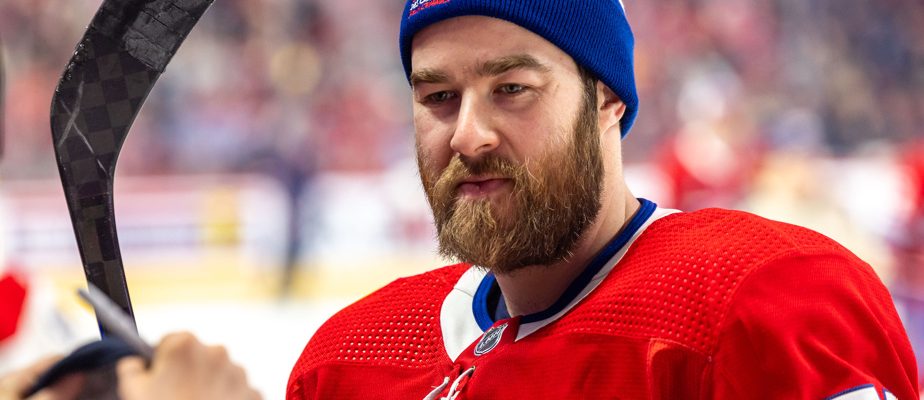Those who secretly dreamed of a first-round pick for defenseman David Savard will be disappointed this morning.
The most coveted defensive right-back on the trade market, Chris Tanev, has just brought the Calgary Flames second-round picks in 2024 and third-round picks in 2026. This third-round pick will become a second-round pick if the Stars of Dallas reach the final this year.
Tanev, 34, 6 feet 2 inches and 193 pounds, played 19:50 in Calgary. His +16 record was the best among Flames defensemen after Noah Hanifin at +17.
Savard, 33 years old, 6 feet 1 inch and 235 pounds, plays 20:22 in Montreal, in the absence of competition. Justin Barron and Johnathan Kovacevic plugged holes on the right for a significant portion of the season, until the transfer of Kaiden Guhle.
In Calgary, despite the presence of Rasmus Andersson and MacKenzie Weegar, Tanev took care of delicate defensive missions. Tanev’s 5-on-5 efficiency coefficient is higher than Savard’s, 49.5% compared to 42.4% for the Canadian defender. In short, Tanev is rated slightly higher, although some tend to overrate him.
The contractual situation of these two defenders differs and complicates the analysis. Tanev is in the final year of a contract at an annual salary of 4.5 million. The Stars had to offer the New Jersey Devils a fourth-round pick to absorb 50% of his salary.
Savard is under contract for another year, at an annual salary of 3.5 million. Clubs will generally give a little more for a player under contract for an extra year, but not necessarily in the case of David Savard.
Within a club aspiring to the Stanley Cup, the Quebecer would probably find himself in a third pair, as was the case in 2021 with Tampa. On the other hand, the top teams are almost all stuck by the salary cap and can hardly afford to pay such a defender more than 3 million.
The CH can nevertheless always keep half of its defender’s salary, it is almost a prerequisite, or even accept an ugly contract in return.
The Stars’ second-round pick is around 60e rank, perhaps further if this powerful club reaches the final four in the playoffs.
Kent Hughes must measure whether Savard’s contribution to the next year, not only an element of stability within a still fragile defense, but a big brother for the organization’s young players, is worth more than a choice of end of second round.
The presence of Savard for another season would also make it possible to avoid throwing a David Reinbacher or a Logan Mailloux, also right-handed defenders, too quickly into the den of the wolf, especially in a 2024-2025 season where the team will want to progress .
There is always a way to draft Lane Hutson at the end of the second round, but Hutson, even if he attracts several CH fans, has not yet proven that he has the makings of a top defender, and nuggets are generally rare at this rank.
Between the 55e and the 66e rank, between 2005 and 2021, the Canadian drafted Riley Kidney, Oliver Kapanen, Mattias Norlinder, Jacob Olofsson, Cam Hillis, Josh Brook, Joni Ikonen, Artturi Lehkonen, Tim Bozon, Joonas Nattinen, Danny Kristo, Olivier Fortier and Ryan White. An 8% success rate…unless you count White as a success with his 61 points in 313 NHL games, which would bump the rate to 12%.
The departure of David Savard for a late second or third round pick would be more worth it next year, a few months before the expiration of his contract.
Women innovate!
The Professional Women’s Hockey League is not afraid to innovate. Their two new rules have been the subject of much discussion since Wednesday, and give ammunition to those who dream of seeing the NHL show more daring.
The rule to prevent the worst teams from intentionally sinking in the standings to get their hands on the top draft pick is interesting. Clubs will accumulate points as soon as they are eliminated and the one with the highest total will get first choice. This regulation will favor the worst clubs in the standings, because they will have more matches to collect points, but they will still have to win their matches to earn the necessary number of points.
The second regulation constitutes a poisoned chalice and disadvantages the leading clubs. Organizations always take maximum precautions at the dawn of the playoffs to avoid motivating the opponent.
By giving the leading club the opportunity to choose its opponent from among the third and fourth place clubs, we offer ammunition to the disadvantaged team. It’s great from a marketing standpoint and the idea will generate a lot of discussion, but not sure that the champion team will be happy to announce their choice…
